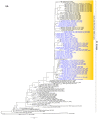Spatiotemporal Dynamics, Evolutionary History and Zoonotic Potential of Moroccan H9N2 Avian Influenza Viruses from 2016 to 2021
- PMID: 35336916
- PMCID: PMC8951762
- DOI: 10.3390/v14030509
Spatiotemporal Dynamics, Evolutionary History and Zoonotic Potential of Moroccan H9N2 Avian Influenza Viruses from 2016 to 2021
Abstract
The H9N2 virus continues to spread in wild birds and poultry worldwide. At the beginning of 2016, the H9N2 Avian influenza virus (AIV) was detected in Morocco for the first time; despite the implementation of vaccination strategies to control the disease, the virus has become endemic in poultry in the country. The present study was carried out to investigate the origins, zoonotic potential, as well as the impact of vaccination on the molecular evolution of Moroccan H9N2 viruses. Twenty-eight (28) H9N2 viruses collected from 2016 to 2021 in Moroccan poultry flocks were isolated and their whole genomes sequenced. Phylogenetic and evolutionary analyses showed that Moroccan H9N2 viruses belong to the G1-like lineage and are closely related to viruses isolated in Africa and the Middle East. A high similarity among all the 2016-2017 hemagglutinin sequences was observed, while the viruses identified in 2018-2019 and 2020-2021 were separated from their 2016-2017 ancestors by long branches. Mutations in the HA protein associated with antigenic drift and increased zoonotic potential were also found. The Bayesian phylogeographic analyses revealed the Middle East as being the region where the Moroccan H9N2 virus may have originated, before spreading to the other African countries. Our study is the first comprehensive analysis of the evolutionary history of the H9N2 viruses in the country, highlighting their zoonotic potential and pointing out the importance of implementing effective monitoring systems.
Keywords: H9N2; Morocco; avian influenza virus; molecular evolution; phylogeny.
Conflict of interest statement
The authors declare no conflict of interest.
Figures




References
-
- Shortridge K.F. Pandemic influenza: A zoonosis? Semin. Respir. Infect. 1992;7:11–25. - PubMed
Publication types
MeSH terms
LinkOut - more resources
Full Text Sources
Medical

